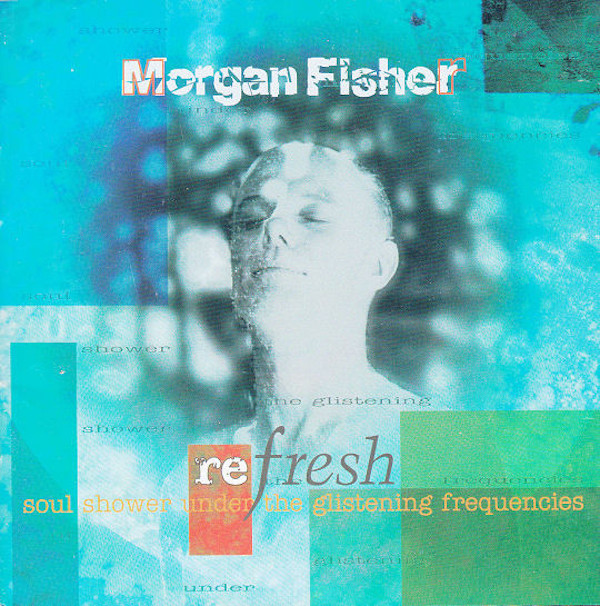
Due to unforeseen circumstances — aka moving all my record collection to a new locale/home — once again I have to go into the well of knowledge, you the readers, have passed on to me to pass on something else back. Today’s post comes courtesy of a great find by sometime guest, Francis Heaney, who when not blowing us away with the gifts of Akira Inoue is sharing behind the scenes really wonderful works like this one: Re:Fresh by Morgan Fisher. Here, Morgan is joined by wonderful Japanese violinist and one time Mekong Zoo member, Aska Kaneko to create an inviting and quite imaginative reimagining of a prior, less known work. What results is this one that is frequently inviting, soothing, joyful, meditative and cheerful — all great things to imbibe in the spirit of early spring.
Morgan Fisher, to quickly refresh (no pun intended!) your memory, was a keyboardist for Mott the Hoople who fell in love with Japan and quickly absconded to it, from said band, to live there for the rest of his life. It was in Japan, Morgan explored his Buddhist spirituality and applied all sorts of influences — some Zen, others in minimalism — to expand his creative spirit into making music that had a very “Eastern” bent. Albums like Look At Life, Water Music, and Flow Overflow, to name precious few, all released in the early to mid ‘80s, somehow, found him carving his space in the Japanese New Age realm (even if wasn’t natively Japanese) and offering his impressionistic melodicism to forward-thinking Japanese acts like dip in the pool.
Aska Kaneko (or Asuka Kaneko, as she goes by now) comes back to us via her kaleidoscopic, virtuoso, session work. If you ever have the chance to read the liner notes to any Japanese release from this era that features wonderful violin work, most likely it’s she who is providing it. You’ve heard Aska in Takami Hasegawa’s L’Ecume Des Jours, Seigen Ono’s Seigén, and Mari Iijima’s Blanche and that’s just in 1984, her first year of credited work… Around this time Aska had come of ginormous, inventive collaborations with groups like Adi, Yumiko Morioka’s Culturemix, and Daisaku Kume plus her own experimental solo career. Morgan couldn’t have picked a better collaborator to bring out something new to this music.
As the story Morgan shares goes, in 1992, he had signed onto to Japanese New Age record label Prem Promotions to release music that kept in tune with his spiritual side. His first project with the label was meant to be to create music that would be sold in convenience stores that catered to Japanese business workers. Even though that promotional aspect fell through, Morgan would carry on making music in the spirit of trying to calm down those having to live through stressful, modern living. Back then he’d release three albums with very concise titles — re·lax, re·charge, and re·fresh — of mostly simple, relaxing, engaging electroacoustic music that was far from the placid western New Age sold in stores.
In 1994, Morgan would revisit the “Re” series trying to figure out what he could do with it. He figured out that the missing element was more of a human element. Morgan rectified this issue by inviting guest musicians to improvise over those older melodies and then reworking them with a fresher combination of sampled or real, acoustic instruments. Malian instrumentalist Mamadou Doumbia, would help him with his first attempt in 1994’s Rebalance, seemingly, transforming that into a livelier, minimal maximal makeover.
Re:Fresh takes the concept of this reimaging into a different, looser, joyful realm. In between Aska naps, Morgan would remake the originals in a more positive light adding brighter arrangements, richer instrumentation and retooling them to fit the jaw-dropping improvisations Aska added in one take when she woke from her slumber. Entirely recorded in Morgan’s home studio, Re:Fresh sounded exactly as it was meant to be, rolling in the freer space he had given himself (and themselves) to create peacefully.
The subtitle for this album: “Soul Shower Under The Glistening Frequencies” perfectly captures the tonal range of the music. On one spectrum we get to listen to “bright” songs — those that feature quite nostalgic-inducing sonics that tug at our heart strings (all perfect canvases for Aska’s searing electric violin strokes). Then the other side of this gamut are the “shine” sound songs where Morgan takes the sonic stage solo to treat us with ear-candy for the mind and spirit.
If ever there was a time to have music on that can cut through all the noise, one shouldn’t travel far to afford going straight to the source for all those not-so-quiet times looking forward.
